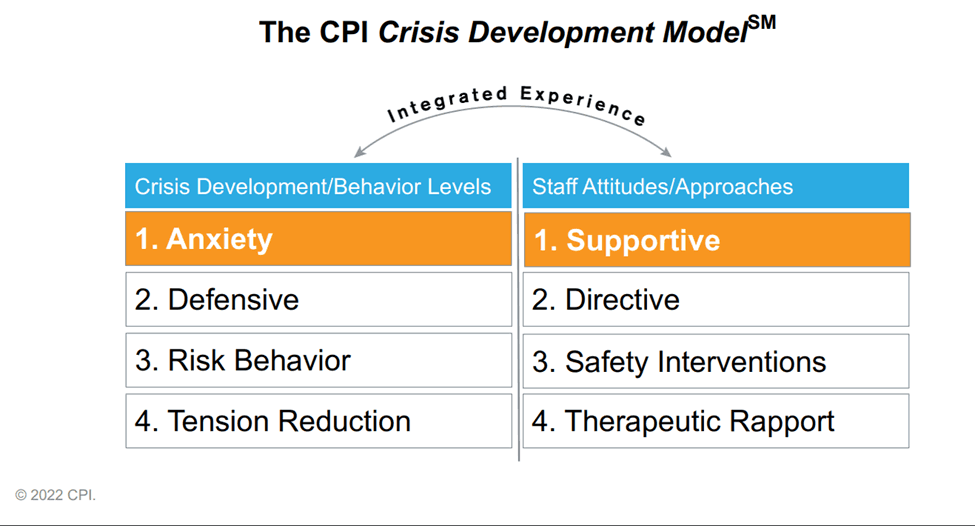
FREE CALL
+1 (951) 332-0807

+1 (951) 332-0807


Know the INTEGRATED EXPERIENCE and how each level of the model and your reaction influences the outcome of the person in your care.
What to do what an individual is anxious
Remember that Behavior influences behavior and you can be the PRECIPITATION FACTOR to someone’s behavior.
What are PRECIPITATING FACTORS: The internal and external things that we don’t always have control over. Can you name some things that affect your behavior?
During a crisis, it is important to not take things personally. You need to remain professional by managing your own behavior and attitude through RATIONAL DETACHMENT.
Remember when we speak to others it is not only the words, we say but the way we say them. This includes the tone, volume, and cadence of our voice. PARAVERBAL COMMUNICATION can express something different than what you are trying to convey and BODY LANGUAGE maintaining appropriate PERSONAL SPACE and how our body is related to the other person can reduce their anxiety and make them more receptive to your help. TOUCH is another way to communicate with empathy and care as a means of comfort to a person who is sad or frightened.
When someone is anxious, it’s important to take the time to listen. by giving them your undivided attention. You can do this by being nonjudgmental and looking for what the person is trying to convey with what they are saying. Paraphrase what they are trying to say to clarify and give them time to think and process the information. Through EMPATHIC LISTENING you can help reduce the anxiety of someone in your care.
Safety is our number one goal for the staff and the people in our care so making sure we are aware of our surroundings, any issues that may have happened during the day, or changes in behavior that may lead to an undesirable reaction. Maintaining a SUPPORTIVE STANCE is a safe and effective way to keep you and the person safe. It maximizes safety and communicates that you respect the person and it’s not threatening. This position reduces the area of exposure should a risk behavior occur and establishes a position to quickly evade should there be a need.
When an individual becomes defensive this can be a very scary time and knowing what to do is paramount to the situation. There are five levels within the defensive level, and they can occur in any order so identifying which one and what intervention to use is critical. The beginning stages of the defensive model is using just information seeking. They are QUESTIONING, and that’s fine if you and the question and move on. Don’t change the subject or get into long discussions or power struggles. That can only lead to the next phase. When the individual starts to REFUSAL and is completely unwilling to do what is asked of him there are several things you can do. Most importantly you need to SET LIMITS. Redirect the person to what it is you want him to do. Don’t talk about what he’s doing wrong since it only feeds their argument.
When setting limits, you need to make sure it is something the person can do. It needs to be REASONABLE. The limit must be SIMPLE enough in words that can be understood. Make it clear, simple, and concrete, and give them time to process the information. Stop talking because it only sounds like Charlie Brown and his Dog Snoopy (Trust me). You also remember to use those paraverbal we talked about. Be RESPECTFUL because they will notice your body language before they listen to what you are saying.
INTERRUPT AND REDIRECT
(Interrupt)Mary, you’re yelling, (redirect) Please lower your voice.
WHEN/THEN PATTERN
(When) Mary, when you stop yelling, I will talk to you (then).
IF/THEN PATTERN
(If) Susan, if you continue to yell in the theater, I will have to ask you to leave.
FAIL-SAFE CHOICE
Susan, I see you are upset, would you like to go talk to me now or we can talk about it later?
When you might have to have a DIFFICULT CONVERSATION with someone, make sure you have a plan and what you are going to say. Be prepared should the person become upset and maintain rational detachment and listen empathically to give them time to process what has been said. Finally, you need to document the conversation and any issues that may have occurred.
Remember to practice the safety and restrictive skills you have learned and if you have questions contact your instructor to refresh any areas of need.
Regardless of where a person falls on the integrated experience, all people go through TENSION REDUCTION. You will see a reduction in breathing and decreased negative body language. The person will be sorry or sad and want to re-establish communication. That’s a good thing and this is when you reach out and re-establish THERAPEUTIC RAPPORT. This is not the time to argue, be angry, or refuse to accept their apology. Remember that RATIONAL DETACHMENT. This is when both the staff and the individual need to regain their own control which is sometimes hard, and if need be, let someone else take over for you. Don’t risk letting the individual re-escalate. In the COPING MODEL we have to look at both staff and the individual:
| Control | Make sure both staff and the individual are back and in control of their own emotions |
| Orient | Make sure both the staff and the person have all the facts about what happened. The who, what when, why, and where. |
| Patterns | Look for any kind of patterns in the behavior. For instance, does it happen at a certain time or with specific staff? It might be hunger, medications, or training issues. |
| Investigate | Look for alternatives on both sides. What could the individual do differently? Talk about using coping skills or coming to the staff. Talk to staff about different ways to approach the client. |
| Negotiate | Talk to the staff and individuals about the expectation of how they can improve their responses in the future |
| Give | Give back the responsibility to both the staff and individuals and let them know that did well. Takeaways never work, they only re-escalate the situation. |
Nonviolent Crisis Intervention works if you work it. I have been teaching Nonviolent Crisis Intervention for 20 years and know it works. Make your book part of your reading material. If you do, it will be there when you most need it.


Our Goal is to provide the tools to improve the Social, Communication and the Life Skills needed through shaping strategies and positive reinforcement and promote independence in all areas of life.
+1 (951)332-0807
info@communicationatoz.net
info@communicationatoz.net
Copyright © 2022 Communication A to Z. All Right Reserved.
IF you woud like to arrange for a consultation appointment with Us. Please fill the Appointment form and we will get back to you as soon as possible.